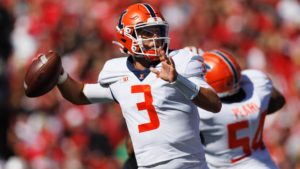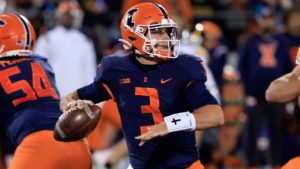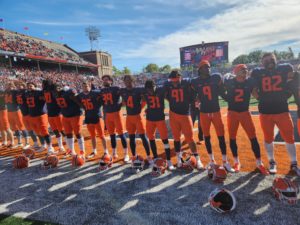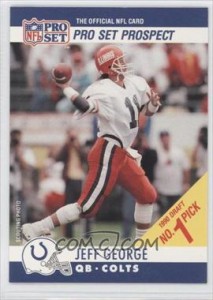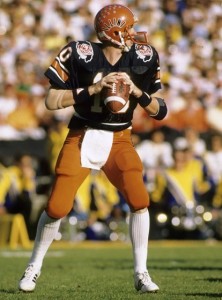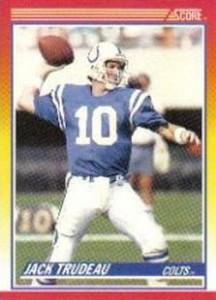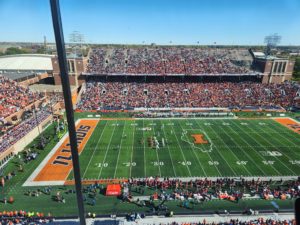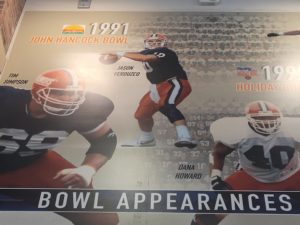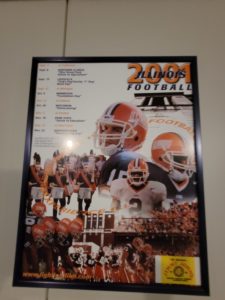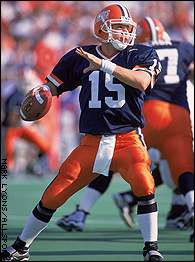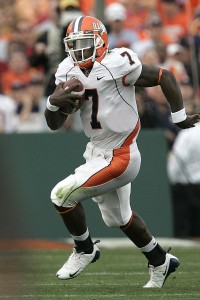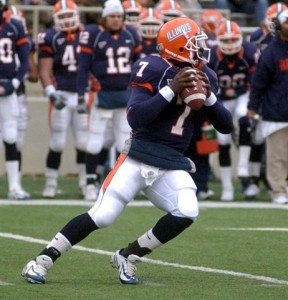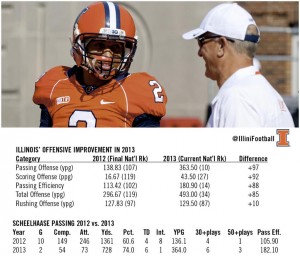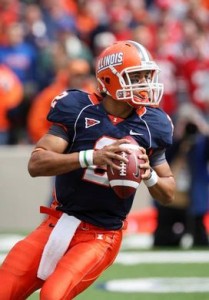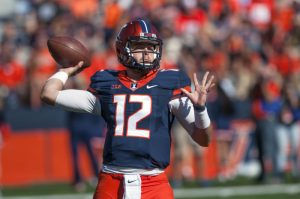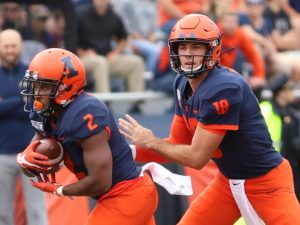As William Shakespeare said, “past is prologue.” If you want to know where you’re going, then you must first become aware of where you’ve been. When Illini football was at its most exciting, and highest in relevancy, the 1980s, they were truly a bona fide NFL quarterback factory.
And whenever the Illini have been good, or better, they have had at least solid, if not excellent quarterback play. And when Illinois has been bad, well, the quarterbacking has been terrible too.
Illini Football (current whereabouts of all living former head coaches)
Illini Football Bowl History
Illini Football Bowl Game Projections
Chicago Bears Passing Record Book Detailed History
It’s not rocket science…or brain surgery. Or “rocket surgery.” Illini football is in its best place that it has been since 2011. And current QB1, Syracuse transfer Tommy De Vito is the best signal caller the program has seen since that era.
DeVito enters Week 9 at Nebraska, ranking 11th nationally in overall passing grade (88.8) and passing grade (86.2) according
to PFF. He’s 138-196 passing on the season (70.4% completion), 10 TDs, two INTs. Good for a 145.8 efficiency rating.
Now is a crest, in the wave that is Illini football history, at the QB position.
Let’s look at some of the ups and downs over the last 40 years.
Since Jeff George became the #1 overall pick in the 1990 NFL Draft, we’ve seen one Illini football player become a school legend at the position (Kurt Kittner, exclusive with him over at this link), and a couple other QBs have spectacular seasons amidst erratically inconsistent careers (Juice Williams, Nathan Scheelhaase).
The rest of it has been…I can’t even legibly type or spell an actual word which effectively articulates the painful, annoying noise that I’m currently making.
Let’s start by flashing back to 1980.
Then QB1 Dave Wilson threw for a school record 621 yards passing in a single game that November against Ohio State. That total stood as the third most in NCAA history for a long time, held the top spot for nine years and it ushered in the era of the modern passing game for the Big Ten conference.
Wilson became the #1 overall pick in the 1981 NFL Supplemental Draft by the New Orleans Saints, and he played with them for eight seasons.
His successor, Champaign Tony Eason, went on to achieve bowl victories with the Illini and a 1985 AFC Title with the New England Patriots in the NFL.
Then we saw Jack Trudeau, who rewrote the school record book, and effectively led the best Illini football team of modernity to Pasadena in 1983.
Certainly, they were the most legendary team off of the field too. Unfortunately, Trudeau has had a lot of dark moments off the field, especially during life after football.
That wasn’t an isolated incident either.
There was a short lull in between the massive successes of Trudeau and the big arm of Jeff George. Next up was Doug Flutie Lite, or a poor man’s Doug Flutie, known as Jason Verduzco.
The 5’8″ Californian saw his career get off to a rip-roaring start, but then diminish towards the end (this theme will reoccur). He put up big numbers early on, but later found himself benched.
Then we entered the Lou Tepper era; a graveyard for QBs.
Johnny Johnson won the Liberty Bowl, and he had some decent other moments, but too often he threw footballs like someone whipping darts at rats on the floor of Kam’s
As maddeningly inconsistent as he was, he was still looked all-B1G compared to the abysmal Scott Weaver.
Weaver hailed from Joe Namath’s hometown (“Joe, it’s just vapor lack!”) but never displayed a fraction of Broadway Joe’s talent. Given the high expectations, Weaver was an extremely polarizing figure.
Then it got much much worse with names like Mark Hoekstra, Tim Lavery, Kirk Johnson etc. etc.
It’s really hard to say any single one of those four QB1 options was any worse than the other, because all four were brutal.
Kurt Kittner was the only shining light in these dark ages. Kittner totally rewrote the school record book and he also led 2001 Illini football to a Big Ten title/Sugar Bowl. Between Verduzco and Kittner, no Illini passer ever topped 300 yards in a single game; not even once.
You can easily make a decent case for Kittner being the best QB in school history.
After Kittner, supposed offensive guru Ron Turner decided to start the weaker armed Dustin Ward, he of rainbow flutter balls aplenty, over the much more talented and physically gifted Jon Beutjer.
Beutjer would get his chance, and he used it to break Red Grange’s Memorial Stadium record for single game total offense…in a loss to San Jose State in 2002.
It took SJSU well over a decade and a half to beat a power five conference team again.
Beutjer would later fizzle, lead some of the worst Illini football teams of the modern era, and then get benched. Yet he’s still the fifth most efficient passer in Illinois history, today.
Then you had a bunch of guys, literally: Tim Brasic, Chris Pazan, Brad Bower, Jacob Charest etc. There’s probably a couple more I’ve forgotten about somewhere.
Juice Williams accomplished the Rose Bowl season of 2007, but his numbers were still pretty blah during that campaign.
Then came 2008, when he put up phenomenal numbers and rewrote the school’s total offense record book. Williams even broke Beutjer’s record, but he still couldn’t lead the team to even a lower tier bowl game during that campaign.
He got benched his senior year, fittingly encapsulating all the ups and all the downs he had as an almost four-year starter in Champaign.
His successor, Nathan Scheelhaase, had a similarly erratic career.
Nate had a solid freshman year, and a fantastic first half to his sophomore year. Then came an atrocious second half of the 2011 season, and an AWFUL junior year (2012).
However, he finished very strong with a great statistical senior season (2013) embracing Cubitism in its finest.
He is now the Illini football career total offense leader; Juice Williams is second.
We’ve also seen some guys come in with HUGE high school accomplishments, HIGH recruiting rankings and ASTRONOMICAL expectations, but leave as never accomplishing much more than “some guy.”
Reilly O’Toole and Aaron Bailey kind of fit this mold (like Brasic), to some degree. Of course, the Illinois coaching staff never let Bailey throw a pass down the field, and that’s kind of an important thing for a QB to get to do.
Thus, the history of Illini football quarterbacking 1991-present equals Kittner, some great moments amidst inconsistency from Juice and Scheelhaase, and a couple other bright spots here and there.
The rest was just a bunch of warm bodies taking snaps, handing off and throwing passes; most of which missed their targets.
Enter Wes Lunt, who came to Champaign, from Oklahoma State, with potential NFL Draft hype. Injury prone, inconsistent and overrated, he still through for 456 yards in one game (against Western Kentucky) and he
Lunt will likely leave school as the seventh all-time leading passer (a spot currently occupied by Johnny Johnson).
He also accomplished the single season passer efficiency record in 2015, although that milestone should come with an asterisk. Lunt spent much of that season out with injury, and it was the portion of the term that included the tougher opponents, with better defenses.
He was healthy for the cupcake mid-major opponents in the non-conference and took enough drop backs to qualify for the record. After him, again came a series of just warm bodies, and that was about it. Jeff George Jr., AJ Bush, Chayce Crouch and I know I’m missing one or two more of these very forgettable names.
Brandon Peters was the best QB of the Lovie Smith era, maybe, with Lunt the only competition. But Peters wasn’t great. He was just football Jalen Coleman-Lands, in school forever.
Artur Sitkowski is at the level of that JGJ, Bush, Crouch grouping, but Tommy DeVito is the real deal, and Illini football fans need to feel thankful for that!
Paul M. Banks is the owner/manager of The Sports Bank and author of “Transatlantic Passage: How the English Premier League Redefined Soccer in America,” as well as “No, I Can’t Get You Free Tickets: Lessons Learned From a Life in the Sports Media Industry.”
He has regularly appeared in WGN, Sports Illustrated and the Chicago Tribune, and he co-hosts the After Extra Time podcast, part of Edge of the Crowd Network. Follow him and the website on Twitter and Instagram.
